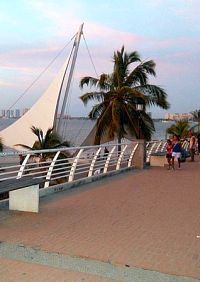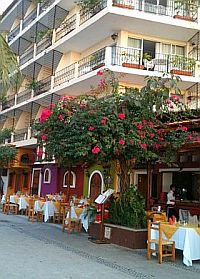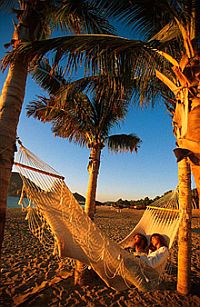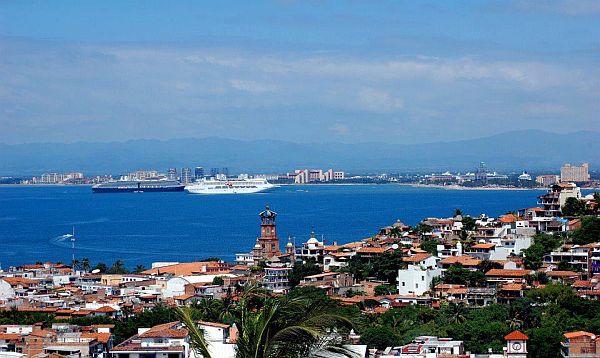Puerto Vallarta, Jalisco, Mexico - Bill is a retired ophthalmologist from Philadelphia. He spends 6 months of the year in Puerto Vallarta, often hosting his children and grandchildren. When I asked Bill if he had any safety concerns, he told me in a serious and direct tone, that he wears a bulletproof vest, has two body guards and carries a side arm wherever he goes. Then he looked me straight in the eyes and asked, "Why would you hesitate to come down here?"
Bill has a wonderfully dry sense of humor and for just a second, I believed him. Then he flashed that "I got you" grin and I realized that this was his comedy routine when asked the "safety" question. In fact, Puerto Vallarta is one of the safest destinations in Mexico.
 |
As one of 60 travel media invited to attend Gala 2019, the annual tourism conference for Puerto Vallarta and neighboring Riviera Nayarit, I had the opportunity to meet with a number of tourism officials and pose questions about the perception by some Americans and Canadians that safety was a consideration when it came to considering Mexico as a holiday destination.
The common response was that most of the violence involved drug cartels and that unless a visitor had intentions of getting involved in illegal activities, there was little to worry about. Oftentimes when violence or natural disasters affect a country, misinformed travelers and even travel advisors tend to stereotype the entire country as having been affected, when in fact the problematic event may have occurred in one specific area.
And then there is the common-sense travel factor that decrees that those who wear "bling," and flaunt their expensive cameras, cell phones and handbags in public, sometimes pay the consequences by having these items stolen. In fact, Bill noted a very high-end BMW on the road just ahead of us and commented that having such a lavish car was equivalent to wearing a billboard that says, "Follow me home ... I'm wealthy."
Some Facts to Consider
Carlos Gerard, the CEO of Puerto Magíco and the person in charge of the cruise port, said that from a cruise perspective, passenger safety goes hand-in-hand with communications. When a cruise passenger takes a taxi or meets an independent tour guide, a form must be completed before the passenger leaves the terminal. That way, there is a record of where the passenger is heading, what the taxi registration number is, and a cell phone number to contact the passenger if required.
Carlos noted that 45,000 Americans and Canadians live in Puerto Vallarta, where the quality of life includes a sense of safety and security.
I asked Saúl Ernesto Sanabria Gibert, the general director of the International Airport of Puerto Vallarta, about the danger of being approached by illegal taxi drivers, a problem that occurs in many international airports. He explained that, in Vallarta, a vehicle can't leave the passenger pick-up zone without showing a special pass, which pretty well does away with the illegal taxi concern.
 |
He continued to provide statistics that, out of 3.7 million tourists, 50.78 percent come from the U.S., 15.62 percent visit from Canada, and 1.51 percent hail from Europe, with the remainder representing visitors coming from Mexico and South America.
Hotel security staff are almost always posted outside the front of the hotel, in the lobby, and on the beach; and as an example, at the Sheraton Buganvilias Resort, where I stayed, I was (happily) questioned by a security guard as I returned to the hotel from an afternoon walk.
Richard Zarkin and Luis Villaseñor, the public relations managers for Riviera Nayarit and the Puerto Vallarta Tourism Board respectively, noted that on the topic of safety and security in Mexico, "the red spots (areas of concern) are focused in particular regions but that the level of violence on the whole, is much lower than in most major cities in the U.S., Canada and globally.
They advised that any time a traveler goes on holiday, there's a certain risk involved, but that the risk is greatly diminished in the Puerto Vallarta/Riviera Nayarit area due to a customer service ethic that is both ingrained and reinforced in the tourism industry. Villaseñor mentioned that, as an example, taxi drivers are educated about calling 911 if they see problems.
Zarkin and Villaseñor continued to speak of hospitality as being in the blood of the people in this part of Mexico, a sentiment I heard repeatedly on this trip and on my last adventure in 2017. People in just about every aspect of tourism have that "May I help you?" attitude toward tourists, whether it's in a major hotel or a small taco restaurant on a side street.
 |
Zarkin and Villaseñor also noted the "Mi casa es tu casa" effect, where surveys of Vallarta visitors confirm that make-you-feel-at-home sensation. And they referred to a 9.5 percent (out of 10) high satisfaction rating from a Finnair survey, citing the people, safety, cleanliness, nature and food as the main factors for returning to Vallarta.
Travelers Agree
Indeed, the best testimonials of a feeling of safety come from the travelers themselves. The most powerful one came from Bill with his bulletproof vest joke; while the most poignant came from Andy, a Millennial from Nova Scotia, whom I met at the airport on departure day. When I asked about any safety concerns, he dismissed it outright and said, "Wow, I could not believe it was 30 Celsius (86°F) every day and the beaches are so amazing and the people were so friendly"; and then he uttered those three magic words that are so dear to tourism: "I'll be back."
Puerto Vallarta is looking to a bright 2019 that includes an expected 34 percent increase in cruise ship arrivals (134 in 2018 compared to an expected 180 in 2019), plus an increase in total visitors from 3.7 million in 2018 to an expected 4.7 million in 2019.
The cornerstone for success and growth at a tourist destination like this one is based on friendliness, happiness, and that enduring feeling of safety.
Original article


